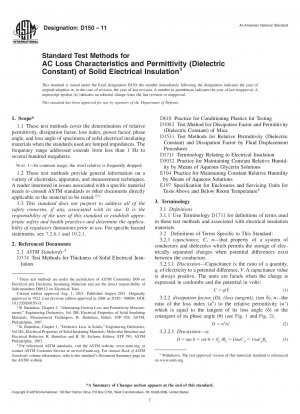ASTM D150-11
Standard Test Methods for AC Loss Characteristics and Permittivity (Dielectric Constant) of Solid Electrical Insulation
- Standard No.
- ASTM D150-11
- Release Date
- 2011
- Published By
- American Society for Testing and Materials (ASTM)
- Status
- Replace By
- ASTM D150-18
- Latest
- ASTM D150-22
- Scope
Permittivity8212;Insulating materials are used in general in two distinct ways, (1) to support and insulate components of an electrical network from each other and from ground, and (2) to function as the dielectric of a capacitor. For the first use, it is generally desirable to have the capacitance of the support as small as possible, consistent with acceptable mechanical, chemical, and heat-resisting properties. A low value of permittivity is thus desirable. For the second use, it is desirable to have a high value of permittivity, so that the capacitor is able to be physically as small as possible. Intermediate values of permittivity are sometimes used for grading stresses at the edge or end of a conductor to minimize ac corona. Factors affecting permittivity are discussed in Appendix X3.
AC Loss8212;For both cases (as electrical insulation and as capacitor dielectric) the ac loss generally needs to be small, both in order to reduce the heating of the material and to minimize its effect on the rest of the network. In high frequency applications, a low value of loss index is particularly desirable, since for a given value of loss index, the dielectric loss increases directly with frequency. In certain dielectric configurations such as are used in terminating bushings and cables for test, an increased loss, usually obtained from increased conductivity, is sometimes introduced to control the voltage gradient. In comparisons of materials having approximately the same permittivity or in the use of any material under such conditions that its permittivity remains essentially constant, it is potentially useful to consider also dissipation factor, power factor, phase angle, or loss angle. Factors affecting ac loss are discussed in Appendix X3.
Correlation8212;When adequate correlating data are available, dissipation factor or power factor are useful to indicate the characteristics of a material in other respects such as dielectric breakdown, moisture content, degree of cure, and deterioration from any cause. However, it is possible that deterioration due to thermal aging will not affect dissipation factor unless the material is subsequently exposed to moisture. While the initial value of dissipation factor is important, the change in dissipation factor with aging is often much more significant.
1.1 These test methods cover the determination of relative permittivity, dissipation factor, loss index, power factor, phase angle, and loss angle of specimens of solid electrical insulating materials when the standards used are lumped impedances. The frequency range addressed extends from less than 1 Hz to several hundred megahertz.
Note 18212;In common usage, the word relative is frequently dropped.
1.2 These test methods provide general information on a variety of electrodes, apparatus, and measurement techniques. A reader interested in issues associated with a specific material needs to consult ASTM standards or other documents directly applicable to the material to be tested. ,
1.3 This standard does not purport to address all of the safety concerns, if any, associated with its use. It is the responsibility of the user of this standard to establish appropriate safety and health practices and determine the applicability of regulatory limitations prior to use. For specific hazard statements, see 7.2.6.1 and 10.2.1.
ASTM D150-11 Referenced Document
- ASTM D1082 Standard Test Method for Dissipation Factor and Permittivity (Dielectric Constant) of Mica
- ASTM D1531 Standard Test Methods for Relative Permittivity (Dielectric Constant) and Dissipation Factor by Fluid Displacement Procedures
- ASTM D1711 Standard Terminology Relating to Electrical Insulation
- ASTM D374 Standard Test Methods for Thickness of Solid Electrical Insulation
- ASTM D5032 Standard Practice for Maintaining Constant Relative Humidity by Means of Aqueous Glycerin Solutions
- ASTM D618 Standard Practice for Conditioning Plastics for Testing
- ASTM E104 Standard Practice for Maintaining Constant Relative Humidity by Means of Aqueous Solutions
- ASTM E197 Specification for Enclosures and Servicing Units for Tests Above and Below Room Temperature
ASTM D150-11 history
- 2022 ASTM D150-22 Standard Test Methods for AC Loss Characteristics and Permittivity (Dielectric Constant) of Solid Electrical Insulation
- 2018 ASTM D150-18 Standard Test Methods for AC Loss Characteristics and Permittivity (Dielectric Constant) of Solid Electrical Insulation
- 2011 ASTM D150-11 Standard Test Methods for AC Loss Characteristics and Permittivity (Dielectric Constant) of Solid Electrical Insulation
- 1998 ASTM D150-98(2004) Standard Test Methods for AC Loss Characteristics and Permittivity (Dielectric Constant) of Solid Electrical Insulation
- 1998 ASTM D150-98 Standard Test Methods for AC Loss Characteristics and Permittivity (Dielectric Constant) of Solid Electrical Insulation
- 1987 ASTM D150-87 Standard Test Methods for A-C Loss Characteristics and Permittivity (Dielectric Constant) of Solid Electrical Insulating Materials
